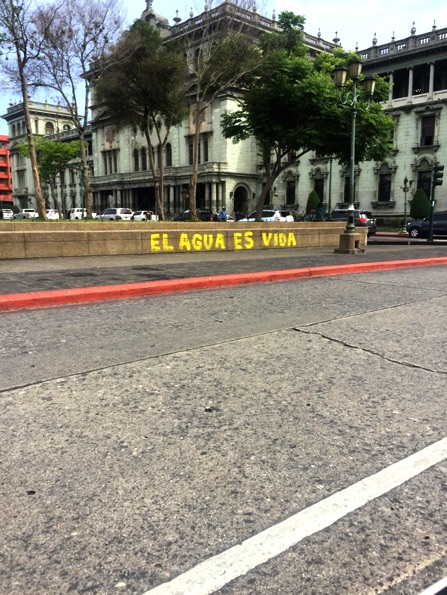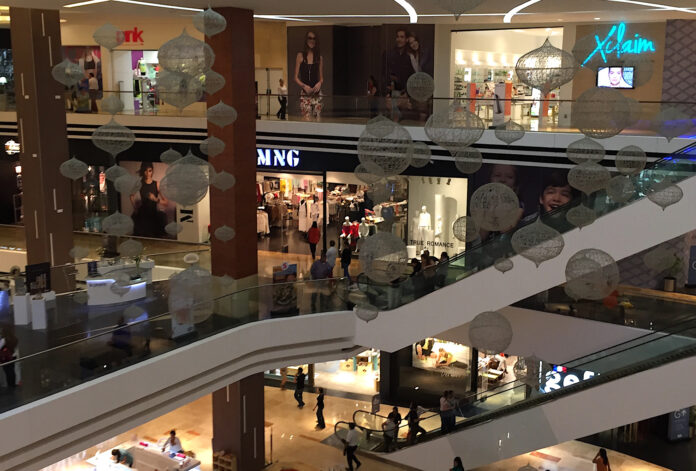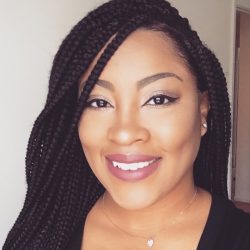
My disdain for the mall stemmed not from the mall, per se, but from the way it stood for the harmful systems of racism and classism disadvantaged Guatemalans face every day.
It was one of the nicest shopping malls I’d ever visited. It was so nice that I almost forgot I was in a developing country.
The Oakland Mall, in Guatemala City’s Zona 10, was enormous – climbing at least three levels, with escalators at nearly every turn. The grand movie theater, Cinépolis, served cocktails and hors d’oeuvres during screenings. Entertainment for children included a carousel, a ball pit big enough for a child to get lost in, and mini electric concept cars that traveled along a track embedded in the floor.
We had been in Guatemala City for two days, and nothing I’d seen so far had prepared me for this.
I lagged behind the group, gaping at the luxe shops advertising global brands, like MAC Cosmetics, Hugo Boss, Zara, L’Occitane en Provence and Swarovski.
I also scanned faces. I saw fair-colored skin, light eyes and hair, and European features. I hadn’t seen faces like these in Guatemala City so far. I was perplexed.
My eyes began to tear up, as I thought of Guatemala’s past and present – the poverty, pain, violence and general suffering experienced predominantly by the indigenous Mayan and other rural peoples, in multiple tragic events. My chest tightened with rage. I hated this mall – the security guards who looked like secret service agents; the grinning woman in the frozen yogurt shop handing out samples; the moms dressed in flowy pastel dresses and way-too-high heels; the friends on the patio, laughing over martinis.
How could a place like this exist in a country where approximately 75% of its population live below the poverty line and 58% live in extreme poverty? Who exactly is allowed to occupy these spaces?
In Guatemala, there is very little middle class. There is the ruling class, characterized by rich and powerful elites, and then there are the exploited, rural poor. Socioeconomic status in Guatemala, as in many places around the world, dictates how comfortably you live, what resources you can access, what spaces you are allowed to occupy and your perceived value in society.
Class separation in Guatemala dates back to the 1500s, when Spain began empire-building in Latin America. Similar to oppressive European rule over African peoples during the transatlantic slave trade, Spanish conquistadores ruled Guatemala by creating a two-tiered system: the “Indios,” or indigenous peoples, and themselves. This dichotomy was upheld by differences in physical features and culture. Indigenous peoples were typically dark-skinned, and had their own distinct languages and spiritual beliefs. The Spanish, with their European features and Catholic faith, emphasized these differences, exercising harsh Eurocentric views, and treating and regarding indigenous people as inferior.
Colonization left Guatemala underdeveloped, created harmful stereotypes and prejudices towards indigenous Mayans and rural peasants, left legacies of perpetual violence, and produced classicist and racist dichotomies. “Indigenous” became synonymous with poor; “Ladino,” as used here in Guatemala, denoted mestizo middle and upper middle class, and “wealth.”
The 1960-1996 civil war, 139 years after Guatemala won independence from Spain, exacerbated oppressive race and class systems. As leftist rebels, who were mainly Mayans, tried to dismantle these systems imposed on them by the heavily Spanish, right-wing hegemonic class, indigenous communities were subjected to heinous acts of violence by the Guatemalan military. These included sexual enslavement of Mayan women, and disappearances of anyone who even remotely opposed the government, and blatant genocide. Over 200,000 people were killed during the civil war, approximately 83% of them of Mayan heritage.
The Peace Accords, a series of agreements geared toward remedying a host of social-economic injustices, were signed in 1996. They finally brought the brutal civil war to an end. However, peace has not come easy for Guatemalans.
Though the majority in Guatemala, Mayans are still treated as second class citizens. Indigenous Guatemalans are constantly reminded of the long-lasting effects of colonization and war, not only through haunting memories of loved ones lost, but in their daily lives.
They didn’t, for example, come to the Oakland Mall.

Many Mayan people and their families live in inadequate houses made of adobe brick and topped with rusty tin roofs, or whatever other scrap material they can find. Many cannot afford to furnish their homes with basic items most of us take for granted, such as beds, ovens, washing machines and TVs.
Clearly this mall was reserved for the tiny Guatemalan elite: mainly “Ladinos,” or non-indigenous, privileged, Westernized residents of mainly Spanish heritage.
Lack of clean water is one of the biggest problems: most impoverished people are stuck with an unreliable, scarce and unsanitary water supply. You might think of clean water as a basic right, but in Guatemala, that too is reserved for the rich. Many people consider this unequal access to clean water a major human rights violation.
Our group’s teaching assistant, a Spanish speaker of Puerto Rican heritage, revealed that he had detected dirty looks and snobby remarks from more than a few Ladino mall shoppers. Even we first-world Western tourists did not belong in the Oakland Mall.
I imagined that any Mayan woman dressed in traditional garb trying to enter would be turned away – at least I didn’t see anyone like that inside. It’s a modern system of segregation that is a reality for many Guatemalan Mayans.
I would be lying if I claimed not to enjoy a leisurely trip to the mall every now and then. In fact, I love to shop, fine dine and go to the movies. My emotions of anger and sadness in the Oakland Mall seemed almost hypocritical, until I realized that my disdain for the mall stemmed not from the mall per se but rather from the way it evidenced the harmful systems of racism and classism disadvantaged people face every day. My emotional response while touring the mall – teary eyes and disbelief – was about compassion.
I’m glad we visited the Oakland Mall, as it perfectly illustrated class differences in Guatemala. My visit made me more sensitive to the plight of indigenous peoples. I am also more aware of the first-world privileges I hold, even as a double-minority (as both African American and a woman) in my own country. So, thank you, Oakland Mall, for teaching me something about race and class. I plan to visit Guatemala again someday – though I won’t be coming to the mall.


